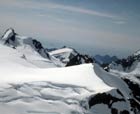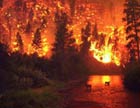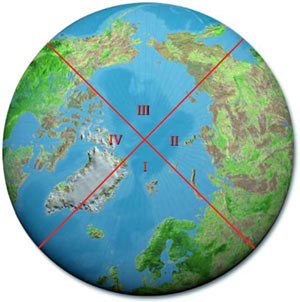



Context - Our climate is already changing, particularly in the Arctic where permafrost is melting, glaciers are receding, and sea ice is disappearing.
Changes in the Arctic will not only affect local people and ecosystems but also the rest of the world, because the Arctic plays a special role in global climate.
How has the climate changed in the Arctic so far, and what future changes are expected?
 This summary was prepared in collaboration with the
International Polar Foundation
This summary was prepared in collaboration with the
International Polar Foundation
This Digest is a faithful summary of the leading scientific consensus report produced in 2004 by the Arctic Climate Impact Assessment (ACIA): "Impacts of a Warming Arctic: Arctic Climate Impact Assessment![]()
1.1 The world’s climate is changing. On average, the temperature on the Earth’s surface has increased by 0.6°C (1°F) over the last two centuries. *1 Most of the warming observed in the past 50 years is attributed to human activities and particularly to the burning of fossil fuels.
Information on past climatic conditions obtained from ice cores and other sources shows that the current increase in global temperatures goes beyond natural climate variability. In the Arctic, average temperatures have risen almost twice as fast as in the rest of the world and climate changes are particularly intense. Changes in the Arctic climate will also affect the rest of the world through increased global warming and rising sea levels. More...
1.2 The Arctic region is the area around the North Pole, essentially an ocean surrounded by land. In the far north, the Arctic is mostly covered by snow and ice, whereas the southernmost part is covered by boreal forests. In between, there is a wide expanse of tundra. The Arctic is home to an array of plants, animals, and people that survive in some of the most extreme conditions on the planet and that are uniquely adapted to such conditions. Climate change, pollution, and growing resource use are factors that put an increasing pressure on fragile Arctic populations and ecosystems. More...
1.3 The Arctic region is home to almost four million people, including an increasing majority of non-indigenous settlers. The Arctic includes Greenland, Iceland, and the northern parts of Norway, Sweden, Finland, Canada, Russia, and the United States. Economically, the region depends largely on natural resources, ranging from oil, gas, and metal ores to fish, reindeer and birds. Recently, the tourism sector has also grown in many parts of the Arctic. More...
Arctic climate is now warming rapidly and much larger changes are projected.
2.1 Evidence of the recent warming of the Arctic is provided by: records of increasing temperatures; melting glaciers, sea ice, and permafrost; and rising sea levels. More...
2.2 Global temperatures are expected to increase further during the 21st century. In the Arctic, this warming is expected to be substantially greater than the global average, and the following changes are expected over the current century * :
These projections assume a gradual warming. However, abrupt and unexpected changes cannot be ruled out. More...
Arctic warming and its consequences have worldwide implications.
Changes in the Arctic can influence the global climate through three major mechanisms. More...
3.1 The amount of the sun’s energy reflected back to space decreases as snow and ice melt, leading to a more intense surface warming. More...
3.2 The melting of Arctic ice and increased regional precipitation can add freshwater to the oceans, and potentially affect ocean currents in the North Atlantic. More...
3.3 As warming progresses, more greenhouse gases could be released into the atmosphere by the thawing of the permafrost. However, warming can increase biological growth, and thus absorption of CO2. More...

3.4 By 2100, melting of Arctic glaciers alone will have contributed to a sea level rise of roughly 5 cm out of the projected 10-90cm total rise for this century. *2 Melting of the Greenland ice sheet may increase this number significantly. More...
3.5 Access to Arctic resources is likely to be affected by climate change, including: wildlife, such as whales, seals, birds, and fish sold on world markets; and oil, gas and mineral reserves.
Arctic ecosystem changes will have an impact on a global scale, notably by affecting migratory species’ summer breeding and feeding grounds. More...
Arctic vegetation zones are likely to shift, causing wide-ranging impacts.
4.1 The Arctic region has three main types of vegetation: polar deserts in the north, boreal forests in the south, and tundra in between. Rising temperatures are expected to favor a northward expansion of boreal forest into the tundra, and of tundra into the polar desert. More...
4.2 The expansion of forest is likely to amplify global warming, because the newly forested areas are darker than the tundra they replace, and absorb more of the sun’s energy. However, this can be somewhat counterbalanced by the fact that they also take up more carbon from the atmosphere. More...

4.3 Due to the warming, insect outbreaks will increasingly disturb large areas of forest. Most scenarios project more forest fires in all ecosystems. More...
4.4 Climate change is expected to increase the range of crops that can be grown in the Arctic and to extend the growing season. However, problems caused by insects, diseases, and weeds are likely to worsen. More...
Animal species’ diversity, ranges, and distribution will change.

5.1 Many Arctic animals, such as polar bears, seals, walruses, and seabirds, rely on the sea’s biological productivity and on the presence of sea ice, both of which are highly dependent on climatic conditions. More...
5.2 Changes in sea surface temperatures or currents could have a strong effect on Arctic marine fish stocks, which are an important food source for the world and play a vital role in the region’s economy. More...
5.3 Rising temperatures could have both positive and negative impacts on the aquaculture of salmon and trout, which is a major industry in the Arctic. More...
5.4 A decline in certain types of vegetation would affect the animals that feed on them (such as lemmings or reindeers). In turn, predators (such as foxes or birds of prey) and human communities that depend on these animals would be affected. More...
5.5 Freshwater ecosystems, such as rivers, lakes, and wetlands are home to a variety of animals. They would be affected by increases in water temperature, thawing of permanently frozen ground, and ice cover breaking up earlier in spring. More...

6.1 Many coastal communities and facilities face increasing exposure to storms.
Rising temperatures are modifying the Arctic coastline and are expected to change it even more in the future. Sea level rise is likely to cause flooding of marshes and coastal plains and accelerate beach erosion. Some towns and industrial facilities are already suffering severe damage as a result of erosion, and are now facing the prospect of relocation. More...
6.2 Reduced sea ice is very likely to increase marine transport and access to resources.
A further decline in the area of Arctic sea-ice will extend the navigation period and allow better accessibility by ship around the Arctic Basin and probably open new shipping routes. More...
6.3 Thawing ground will disrupt transportation, buildings, and other infrastructure
The melting of the permafrost layer poses significant engineering challenges for roads, buildings, pipelines, and industrial facilities. New construction will require deeper foundations, thicker insulation, and other preventive measures that will increase construction costs. More...
7.1 Indigenous communities are facing major economic and cultural impacts.
The many indigenous communities whose cultures and activities are shaped by the Arctic environment are facing new challenges because of climate change, in addition to those posed by current social, economic, and political conditions. They find weather less stable and predictable, and are affected by changes in snow and sea ice. More...
7.2 Elevated ultraviolet radiation levels will affect people, plants, and animals.
The increase of ultraviolet (UV) radiation reaching the Earth’s surface as a result of the thinning of the ozone layer has negative effects on humans, animals and plants in the Arctic, particularly in the spring when living organisms are most vulnerable. More...

7.3 Multiple influences interact to cause impacts to people and ecosystems.
The ability of the Arctic populations to cope with the impacts of climate change will be greatly affected by political, legal, and socioeconomic factors such as growing populations, urbanization, or self-determination movements. More...
In a region as large as the Arctic, there are significant sub-regional variations in climate. Recent warming has been more dramatic in some regions than in others. Moreover, local features of the natural world and societies create differences in what impacts will occur and which will be most significant locally.
The Arctic Climate Impact Assessment (ACIA) focuses on four sub-regions and considers a series of key impacts:

Sub-region I: From East-Greenland to Northwest Russia
Sub-region III: From Chukotka to the Western Canadian Arctic
Sub-region IV: Central and East Canadian Arctic and West-Greenland
The Arctic Climate Impact Assessment (ACIA) represents the first effort to comprehensively examine climate change and its impacts in the Arctic region, bringing together the findings of hundreds of scientists and the insights of indigenous people.
There remain important gaps in knowledge that will require improved long-term monitoring, studies of ecosystem processes, climate modeling, as well as analysis of impacts on society. The International Polar Year (in 2007-2009) will be an opportunity to improve our understanding of the impacts of climate change. More...
Climate change presents a major and growing challenge to the Arctic and the world as a whole. Implications are particularly great for future generations that will face the consequences of current action or inaction.
10.1 Resulting environmental changes will present risks as well as opportunities across the Arctic. For example, the large reduction in summer sea ice threatens the future of several ice-dependent species but will also increase marine access to resources and population centers. More...
10.2 The scenarios used in this assessment assume that changes will be gradual. However, because of the complexity of the Earth’s climatic system, major surprises are possible if climate evolves differently. Ocean currents, in the North Atlantic might undergo major changes with wide-ranging consequences for climate. More...
10.3 Impacts of changing climate in the Arctic are already being widely observed and felt. They provide an early indication for the rest of the world of the significance of climate change. The changes will also reach far beyond the Arctic, affecting global climate, sea level, biodiversity, and many aspects of social and economic systems. Climate change in the Arctic thus deserves and requires urgent attention by decision makers and the public worldwide. More...
| Arctic climate is now warming rapidly and much larger changes are projected. | More in 2 ... |
| Arctic warming and its consequences have worldwide implications. | More in 3 ... |
| Arctic vegetation zones are likely to shift, causing wide-ranging impacts. | More in 4 ... |
| Animal species' diversity, ranges, and distribution will change. | More in 5 ... |
| Many coastal communities and facilities face increasing exposure to storms. | More in 6 ... |
| Reduced sea ice is very likely to increase marine transport and access to resources. | |
| Thawing ground will disrupt transportation, buildings and other infrastructure. | |
| Indigenous communities are facing major economic and cultural impacts. | More in 7 ... |
| Elevated ultraviolet radiation levels will affect people, plants, and animals. | |
| Multiple influences interact to cause impacts on people and ecosystems. |

This summary is free and ad-free, as is all of our content. You can help us remain free and independant as well as to develop new ways to communicate science by becoming a Patron!